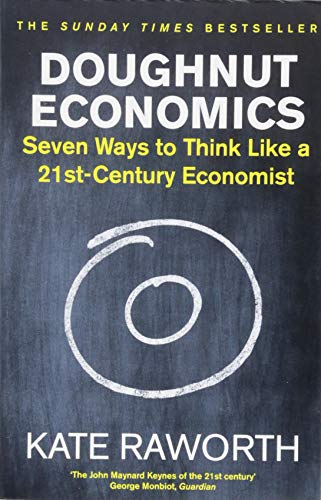Book Title: Doughnut Economy – Seven Ways to Think Like a 21st-Century Economist
Author: Kate Raworth
ISBN: 9781847941398
A few weeks ago I reviewed the book ‘The Growth Delusion’ by David Pilling. That book documents, outlines and explains how the GDP came into being, what it does measure (well) and what it does not measure (well, or at all).
While Pilling’s book did look into alternatives to the GDP, it fell short of proposing a vision of viable and valid alternatives.
And that is precisely where Kate Raworth’s work sets in.
Raworth is herself an economist and academic, with both Oxford as well as Cambridge University, and with a globally recognised track record of working and collaborating with international organisations such as Oxfam, the UNDP and others. What she presents in this book is cumulated insight of several decades of both theoretical and field work. All formulated in extremely accessible language accompanied by clear, simple yet rich visuals.
The book is structured into 1 + 7 + 1 chapters: the first chapter summarises the historic and factual backdrop (by and large overlapping with Pilling’s book), and the last chapter is a very short call to action to everyday citizens that encourages everyone to question the economic ‘modus operandi’ we have been brought up with and used to for probably our entire lives.
The intermittent 7 chapters outline step by step different challenges, questions and issues that need to addressed, fixed and solved in order to create an economic system that is long-term viable, entailing fewer of the non-functional attributes that the current system has. Examples, from small to large, where niche operators and activities are implementing ‘the new economic reality’ already, are given, including the rational as to why those approaches could work in practice.
The following animated in 8 short videos summarise the 7 key chapters (and the link up between them) of the book simply and succinctly:
Models: Main-streaming Economic Thinking
Economic thinking in any moment in time, always depended upon, if not to say built upon, models. Most of those models have been purposely simplified to reduce complex issues to more easy to understand processes. So far so good.
The fundamental issue with most models though is, right through to the present time, that the simplification did leave out
- relevant context
- crucial interdependencies
- fundamental side effects and collateral damage (typically denominated ‘externalities’).
Raworth, model by model, gives us an idea how the most important dominating models fall short to represent reality and life as it is. She outlines the knock-on effects of each model’s flaws and mistakes causes. And how in fact the models, due to the simplification role they were intended to have, also are at the heart of many systemic ‘malfunctions’ we see and experience in the current time and age.
An example of this can be appreciated in illustrated form in the following 2 blog posts on her website:
Alternatives: There is no silver bullet – just hard work
One of the key points, and possibly where many readers might be disappointed: Raworth does not pretend that she know all the solution on HOW to implement her strategic and conceptual examples.
She does however list many an example on how bits and pieces of needed ingredients are being experimented with (e.g. local currencies in various geographies in the world), the challenges they encounter and the successes they have.
In fact, the fascinating aspect of this book is indeed the fact that it paints an extremely clear vision and a rationale as to WHY the new vision needs to be as outlined. But allows each and every reader the freedom and liberty to take that vision and ponder about how to turn it into reality.
By only giving a relevant set of examples, taken and scattered from around the globe, the call for action also contained in the book is rather quite evident.
Conclusion
While examples are not scarce in this book, unsurprisingly one pins for many, many more of them. And it is exactly that unfulfilled expectation – one that was impossible to live up to to start with – together with the simple and accessible language used, that may possibly be seen rather as a weakness to the book and what it tries to convey.
Personally, I am not a fan of Raworth’s language – I think the editorial team could have done a significantly better job in maintaining ease of language while steering clear of what sometimes even to a non-native reader like myself, feels somewhat too close to ‘sloppy’ a linguistic style.
That said: The reader is well advised to ignore the weakness, and just be grateful that rather than economic jargon, mostly well understandable everyday language is used across the book.
The concepts illustrated and reflected upon are intellectually quite demanding. Even more so if one dwells on the large scale impact and paradigm shifts that result as a consequence. But also considering the trade offs that are being decided upon every day by those in power – politicians or global CEOs – and for which we will end up paying the full price rather sooner than later.
Further Learning:


